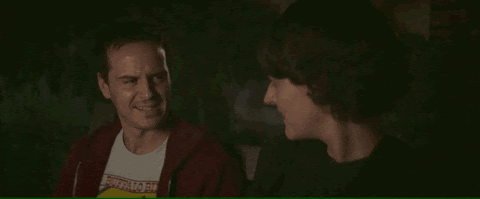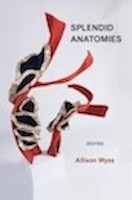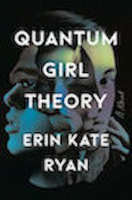
VOICEOVERS, ASIDES AND IMPLICATING THE AUDIENCE
Guys, this one is about FLEABAG.

Okay, cats & kittens. It's FLEABAG time.
We recently talked to you about narrative voices (voiceovers, in TV-ville). This month, we're looking at the old-fashioned ASIDE, which Phoebe Waller-Bridge made new again in the second season of FLEABAG. (Uh, yeah, spoilers ahead.)

In season one, Fleabag's narrative asides (speaking directly to the camera) function in a familiar way: giving the audience insight into her interiority. Recall, as writers for the page, you have (and can give your readers) direct access to interiority, something a playwright/television writer cannot do without either a voiceover or an aside.
In season two, however, the narrative asides take on a deeper and more slant meaning when Fleabag's love interest, the Hot Priest, both notices her "disappearance" (when her face turns toward the camera, see image above) ...and sometimes actually hears Fleabag's aside ("his beautiful neck"). Wait a minute -- we thought only the viewer could hear those asides! A strange thing happens when that priest enters the space reserved for us, at home, watching the TV show. And then we, the audience, get to see Fleabag's reaction, which pulls us into an even more intimate relationship with Fleabag; we aren't merely her confessors, we're in league with her.
What was your experience as the viewer, then, when in the last moments of the series, Fleabag indicates with a shake of her head that we can stay put, that she doesn't need us anymore? Maybe it helps to reveal the intertwined nature of the relationship between character/audience: she was as attached to us as we were to her. By breaking the rules (not only the fourth wall, but the rules of the fourth wall), Fleabag creates a particular emotional implication for the audience. In short, despite the rumors, metafiction can actually be more emotionally resonant than realistic fiction.
Think for a second about children's books. Characters break that fourth wall all the time, identifying themselves as within books, within bound paper and acknowledging the labor of the reader. The Monster at the End of this Book, The Book With No Pictures... kids may not know that a bunch of literary "rules" are being flouted, but they do know that a book is talking directly to them, about them, and it does a lot to engage them both in that book and in the idea of books in general.
Metafiction is playful and it can have different effects. It can certainly take us out of a story, reminding us of the contrivance of it all. But, we contend, it can also pull us further in. It can make us feel like we are participating in the story, instead of just watching.
Writing Prompt: Try to capture the feeling you get when the Hot Priest enters the your space as the viewer, when he notices what you've pretended not to notice -- that all action stops when Fleabag turns to address you. How can you give your reader that gift, of stepping all the way into a character's world, implicated in her actions and the decisions she makes?
Take a story you've already drafted and add a metafictional element, a direct address to the reader, say, or a character who suddenly notices the structure of the story. See what you can unsettle in the reader's relationship to the story. Maybe you won't like what you find and you'll pluck this element right back out. Or maybe something wonderful will break loose. You won't know until you try it.
Recommended viewing and reading: Fleabag, seasons 1 & 2; The Monster at the End of This Book by Jon Stone, The Book with No Pictures by BJ Novak, Don't Let the Pigeon Ride the Bus by Mo Willems, We Are in a Book by Mo Willems, Growing Pains 3x10: "This Is Your Life," The Princess Bride, "The Husband Stitch" by Carmen Maria Machado; Wicket's Remedy, Stranger Than Fiction, The OA (final episode), BH90210 (reboot), Scrooged (ending credits), A Tale for the Time Being by Ruth Ozeki, Long Division by Kiese Laymon; If on a Winter's Night a Traveler by Italo Calvino (!!)
Reflection: How subtle did you choose to go with your metafictional element? Sometimes it doesn't take much. Consider the single line from the Buffy musical: "I think this line is mostly filler." We remember for just a second the agreement we've made with the artwork's creator (suspension of disbelief), and when it's deployed well, we can feel tingly things in our brain.
But how do you pull the viewer/reader back in after you've deployed your tingles?
[subtle head shake, you can go now.]

The Minneapolis Storytelling Workshop is a project of writers Erin Kate Ryan and Allison Wyss, who have also written books.



On December 1, 1946, Paula Jean Welden put on a bright red parka and disappeared into the Vermont wilderness; how many lives might she have led since then? Purchase Quantum Girl Theory.
A rhinoplasty model meets a phantom pregnancy meets a human metal detector in this humorous and poignant collection about grotesque and glorious bodies. Purchase Splendid Anatomies.
Minneapolis Storytelling Workshop is a project of professional writers Allison Wyss and Erin Kate Ryan. All rights reserved.